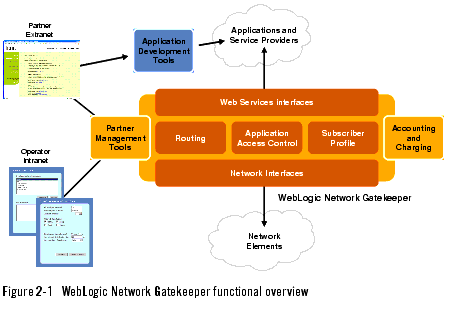Product Description
|
|
Get Adobe Reader |
WebLogic Network Gatekeeper Introduction
The following sections provide an overview of WebLogic Network Gatekeeper functionality:
Overview
With the WebLogic Network Gatekeeper and its optional modules, operators can:
- Expose standard network capabilities (SMS, MMS, ) as telecom Web Services to third-party service providers
- Integrate and policify operator specific and legacy APIs
- Enforce real-time application authorization and access control
- Protect subscriber privacy
- Facilitate automation of third-party service provider and application provisioning and administration
- Integrate with existing billing, rating and settlement systems
- Reduce application development time
Functions and benefits overview
The below functions are described in detail in the following chapters of the document.
Wide range of APIs based on Web Services standards
By exposing both traditional (legacy) telecom service APIs and new high-level web services, operators and application developers can select the most appropriate APIs for each application. The selection can be based on, for example, performance requirements, application complexity, or developer skills.
In addition, current applications using, for example SMPP and CIMD can be integrated with the WebLogic Network Gatekeeper "as is" and thereby leverage current application investments. That is, they can take advantage of the policy, charging, and SLA enforcement mechanism offered by the WebLogic Network Gatekeeper.
Common access control point for both internal and 3rd party applications
The integrity of the network and thesubscriber is secured by common authentication, authorisation, aliasing and access control procedures.
Policy-based execution for flexible application access control
Policy-based application access control allows the operators to dynamically customise both the Service Level Agreement (SLA) data and the actual access rules to fit their business models and security requirements.
Subscriber privacy and subscriber profile data
Using policy and subscriber profile data, the WebLogic Network Gatekeeper can perform a number of subscriber related checks before a service request is accepted. For example, WebLogic Network Gatekeeper can control which services the subscriber has subscribed to, payment method to use, account status, subscriber specific white and blacklists, and if aliasing shall be used. These checks are applied on both application and network initiated requests.
Wide range of standard network service capabilities
By providing a large set of standard network protocols operators can quickly provide applications with access to GSM, GPRS, SIP, IN and 3G service nodes directly through IP-based service nodes (SMSC, MMSC, ) or via OSA/Parlay gateways.
Built-in network routing
The WebLogic Network Gatekeeper routes service requests to the appropriate network nodes based on address plans and actual destination address.
Extensible application and network interfaces
Using a modular architecture where both the application and network interfaces are extensible makes it easy for operators to create attractive service offerings based on their unique network service capabilities. Also, new application and network interfaces are easily added when new or enhanced service capabilities are introduced in the networks.
Enhanced network protection
Service providers can be given various priority levels and their network access can be handled accordingly. The main functions provided by the WebLogic Network Gatekeeper are:
Carrier grade and fully scalable architecture
The highly distributed and replicated system provides carrier grade performance. Linear scalability of both software and hardware allow operators to increase the capacity as the traffic and number of applications grow.
Optional modules for more operator value
To facilitate advanced accounting and charging, application development, and partner management, the following optional modules are available for the WebLogic Network Gatekeeper:
Partner Management Tools
This module provides operators with tools to manage large sets of partners. The tools support automation of traditionally work intensive tasks such as registration, activation, administration and supervision of 3rd party and in-house service providers and their applications.
The tools also allow operators to create groups of partners sharing sets of data. This functionality can be used for tiering or segmentation of partners allowing operators to focus their administrative and partner management resources on the most rewarding partners.
Application Development Tools
This module provides application developers with a set of development tools that allows them to work in standard development environments. The module consists of the following:
- Controls for BEA WebLogic Workshop
- Web Services WSDL files including API desciptions
- Developers' Guides
- A graphical test and verification environment
Supporting standards based development environments, the application development tools allow application developers to concentrate on the APIs instead of proprietary development environments. This gives the developers a head start and reduces development time.
